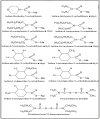Application of Dithiocarbamates as Potential New Antitrypanosomatids-Drugs: Approach Chemistry, Functional and Biological
- PMID: 31374887
- PMCID: PMC6695843
- DOI: 10.3390/molecules24152806
Application of Dithiocarbamates as Potential New Antitrypanosomatids-Drugs: Approach Chemistry, Functional and Biological
Abstract
Dithiocarbamates represent a class of compounds that were evaluated in different biomedical applications because of their chemical versatility. For this reason, several pharmacological activities have already been attributed to these compounds, such as antiparasitic, antiviral, antifungal activities, among others. Therefore, compounds that are based on dithiocarbamates have been evaluated in different in vivo and in vitro models as potential new antimicrobials. Thus, the purpose of this review is to present the possibilities of using dithiocarbamate compounds as potential new antitrypanosomatids-drugs, which could be used for the pharmacological control of Chagas disease, leishmaniasis, and African trypanosomiasis.
Keywords: African trypanosomiasis; Chagas disease; DETC; Trypanosomatids; antiparasitic activity; dithiocarbamates; leishmaniasis.
Conflict of interest statement
The authors declare no conflict of interest.
Figures








Similar articles
-
Exploring the Potential of Natural Products as Antiparasitic Agents for Neglected Tropical Diseases.Curr Top Med Chem. 2024;24(2):89-108. doi: 10.2174/0115680266256963230921061925. Curr Top Med Chem. 2024. PMID: 37842892 Review.
-
Bisphosphonate-Based Molecules as Potential New Antiparasitic Drugs.Molecules. 2020 Jun 3;25(11):2602. doi: 10.3390/molecules25112602. Molecules. 2020. PMID: 32503272 Free PMC article. Review.
-
Organometallic compounds in the discovery of new agents against kinetoplastid-caused diseases.Eur J Med Chem. 2018 Jul 15;155:459-482. doi: 10.1016/j.ejmech.2018.05.044. Epub 2018 Jun 1. Eur J Med Chem. 2018. PMID: 29908440 Review.
-
Metal Compounds in the Development of Antiparasitic Agents: Rational Design from Basic Chemistry to the Clinic.Met Ions Life Sci. 2019 Jan 14;19:/books/9783110527872/9783110527872-019/9783110527872-019.xml. doi: 10.1515/9783110527872-019. Met Ions Life Sci. 2019. PMID: 30855114 Review.
-
An Overview on Target-Based Drug Design against Kinetoplastid Protozoan Infections: Human African Trypanosomiasis, Chagas Disease and Leishmaniases.Molecules. 2021 Jul 30;26(15):4629. doi: 10.3390/molecules26154629. Molecules. 2021. PMID: 34361781 Free PMC article. Review.
Cited by
-
Silver Nanoparticles Containing Fucoidan Synthesized by Green Method Have Anti-Trypanosoma cruzi Activity.Nanomaterials (Basel). 2022 Jun 15;12(12):2059. doi: 10.3390/nano12122059. Nanomaterials (Basel). 2022. PMID: 35745396 Free PMC article.
-
Synthesis, Crystal Structures and Anticancer Studies of Morpholinyldithiocarbamato Cu(II) and Zn(II) Complexes.Molecules. 2020 Aug 6;25(16):3584. doi: 10.3390/molecules25163584. Molecules. 2020. PMID: 32781741 Free PMC article.
-
The Versatility in the Applications of Dithiocarbamates.Int J Mol Sci. 2022 Jan 24;23(3):1317. doi: 10.3390/ijms23031317. Int J Mol Sci. 2022. PMID: 35163241 Free PMC article. Review.
-
Design, synthesis and bioactive properties of a class of macrocycles with tunable functional groups and ring size.Sci Rep. 2022 Mar 21;12(1):4815. doi: 10.1038/s41598-022-08775-z. Sci Rep. 2022. PMID: 35314752 Free PMC article.
-
Synthesis of Water-Soluble Copolymers of N-vinylpyrrolidone with N-vinyldithiocarbamate as Multidentate Polymeric Chelation Systems and Their Complexes with Indium and Gallium.Molecules. 2020 Oct 14;25(20):4681. doi: 10.3390/molecules25204681. Molecules. 2020. PMID: 33066394 Free PMC article.
References
-
- Debus H. Ueber die verbindungen der sulfocarbaminsäure. Justus Liebigs Ann. Chem. 1850;73:26–34. doi: 10.1002/jlac.18500730103. - DOI
Publication types
MeSH terms
Substances
LinkOut - more resources
Full Text Sources
Medical

